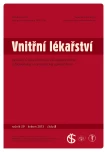Comparison of MRCP a ERCP in Diagnosis of Choledocholithiasis
Authors:
J. Vaníček 1; H. Kyselová 1; Bohuslav Kianička 2; R. Mikulicová 1; B. Bajgarová 1; J. Trna 3; M. Souček 2; I. Řiháček 2; J. Špác 2
Authors‘ workplace:
Klinika zobrazovacích metod Lékařské fakulty MU a FN u sv. Anny Brno, Mezinárodní centrum klinického výzkumu FN u sv. Anny Brno, přednosta MU Dr. Jiří Vaníček, Ph. D.
1; II. interní klinika Lékařské fakulty MU a FN u sv. Anny Brno, přednosta prof. MU Dr. Miroslav Souček, CSc.
2; III. interní gastroenterologická klinika Lékařské fakulty MU a FN Brno, pracoviště Bohunice, přednosta prof. MU Dr. Aleš Hep, CSc.
3
Published in:
Vnitř Lék 2013; 59(5): 357-360
Category:
Original Contributions
Overview
Introduction:
Choledocholithiasis is the most common cause of biliary obstruction. Each of the testing methods used in its diagnosis has its advantages and disadvantages.
Objective of the study:
The objective of this prospective study is to compare endoscopic retrograde cholangiopancreatography with magnetic resonance cholangiopancreatography in the diagnosis of choledocholithiasis on the basis of own experience and literature data.
Set of patients and methodology:
The set was studied from the beginning of 2007 to the end of 2012 (i.e. six years). The study assessed prospectively 45 patients (age range 28– 72 years) with symptoms of biliary obstruction, who first underwent magnetic resonance cholangiopancreatography and subsequently endoscopic retrograde cholangiopancreatography.
Results:
The sensitivity, specificity and diagnostic accuracy of magnetic resonance cholangiopancreatography was lower, both in our set of patients and according to the literature data, compared to the endoscopic retrograde cholangiopancreatography (92%, 91% or 93 %).
Conclusion:
Considering the frequency of complications (in some cases serious ones) following endoscopic retrograde cholangiopancreatography, the magnetic resonance cholangiopancreatography is, in spite of its lower sensitivity, the method of choice in the diagnosis of choledocholithiasis by means of non‑invasive methods, on the basis of which it is possible to refer the patients subsequently for therapeutic endoscopic retrograde cholangiopancreatography.
Key words:
choledocholithiasis – magnetic resonance cholangiopancreatography – endoscopic retrograde cholangiopancreatography
Sources
1. Maple JB, Ben‑ Menachem T, Anderson MA et al. The role of endoscopy in the evaluation of suspected choledocholithiasis. Gastrointest Endosc 2010; 71: 1– 9.
2. Petrtýl J Endoskopická retrográdní cholangiografie a perkutánní přístupy v diagnostice a léčbě onemocnění žlučových cest. Projekt – endoskopie.cz [online]. Studijní materiály [cit. 2012– 12– 13]. Dostupné z: http:/ / www.projekt‑ endoskopie.cz/ attachment/ ERCP_a_perkutanni_pristupy.ppt
3. Citron PB, Garrow DA, Gallagher J et al. Risk factors for complications after ERCP: a multivariate analysis of 11.497 procedures over 12 years. Gastrointest Endosc 2009; 70: 80– 88.
4. Karakan T, Cindoruk M, Alagozlu H et al. EUS versus ERCP for patiens with intermediate probability of bile duct stones: a prospective randomized trial. Gastrointest Endosc 2009; 69: 244– 252.
5. Vázquez‑ Sequeiros E, González‑ Panizo Tamargo F, Boixeda‑ Miquel D et al. Diagnostic accuracy and terapeutic impact of endoscopic ultrasonography in patients with intermediate suspicion of choledocholithiasis and absence of findings in magnetic resonance cholangiography. Rev Esp Enferm Dig 2011; 103: 464– 471.
6. Reimer P, Parizel PM, Stichnoth FA. Clinical MR imaging: A practical approach. Springer 2003, 302– 303.
7. Kim TK, Kim BS, Kim JH et al. Diagnosis of intrahepatic stones: superiority of MR cholangiopankreatography over endoscopic retrograde cholangiopankreatography. AJR Am J Roentgenol 2002; 179: 429– 434.
8. Pavone P, Laghi A, Catalano C et al. MRI of the biliary and pancreatin ducts. Eur Radiol 1999; 9: 1513– 1522.
9. Žižka J, Klzo L, Ungermann. L Zobrazování jater a žlučových cest magnetickou rezonancí. Postgraduální medicína 2006; 8: 74– 76.
10. Pasanen P, Partanen K, Pikkarainen P et al. Ultrasonography, CT, and ERCP in the diagnosis of choledochal stones. Acta Radiol 1992; 33: 53– 56.
11. Zandrino F, Curone P, Benzi L et al. MR versus multislice CT cholangiography in evaluation patients with obstruction of the biliary tract. Abdom Imaging 2005; 30: 77– 85.
Labels
Diabetology Endocrinology Internal medicineArticle was published in
Internal Medicine

2013 Issue 5
Most read in this issue
- Diastolic dysfunction in the elderly subjects. Disease or a physiological manifestation of ageing?
- Spondyloarthritides: Current Perspective on Diagnosis and Classification
- Comparison of MRCP a ERCP in Diagnosis of Choledocholithiasis
- Gluten induced diseases
